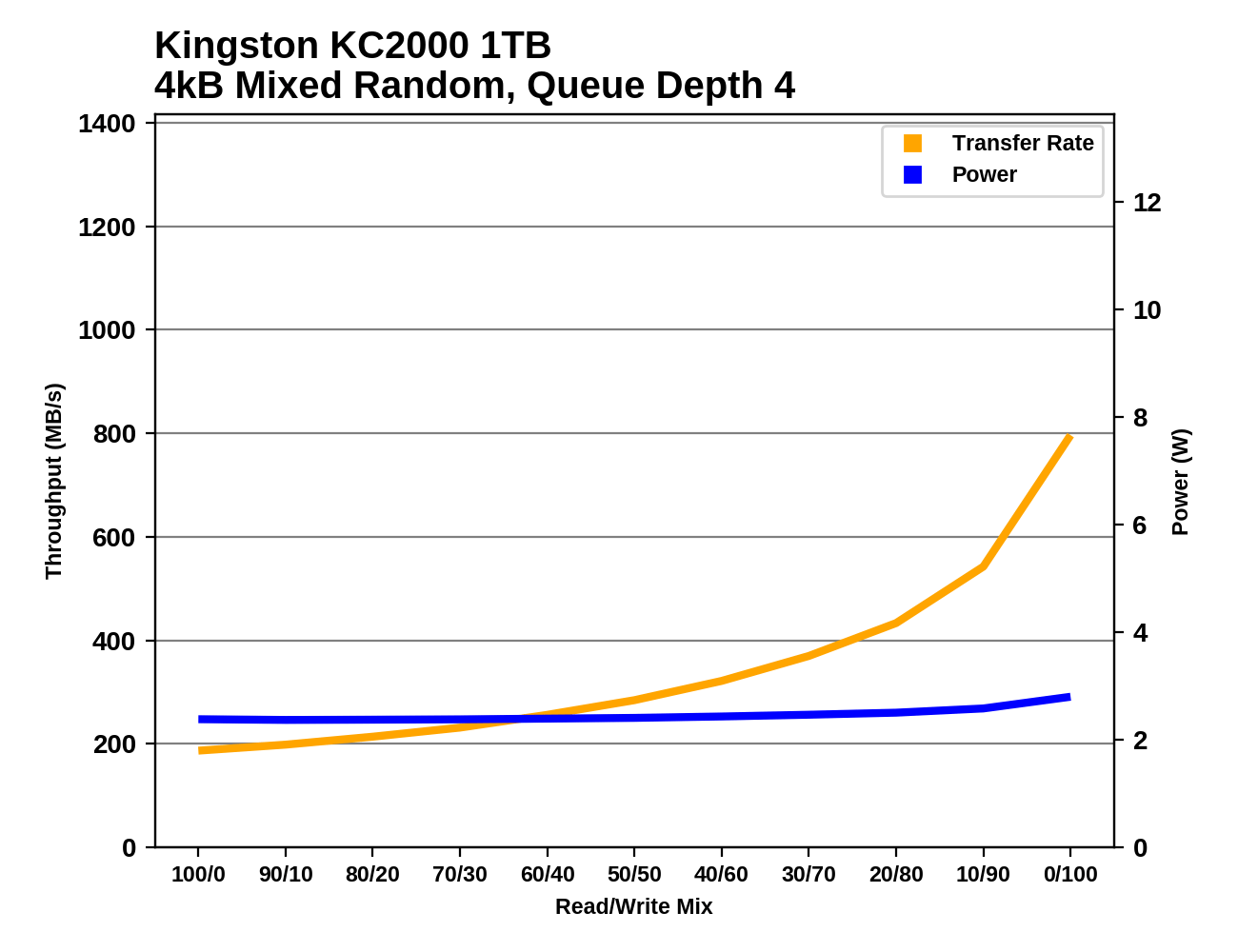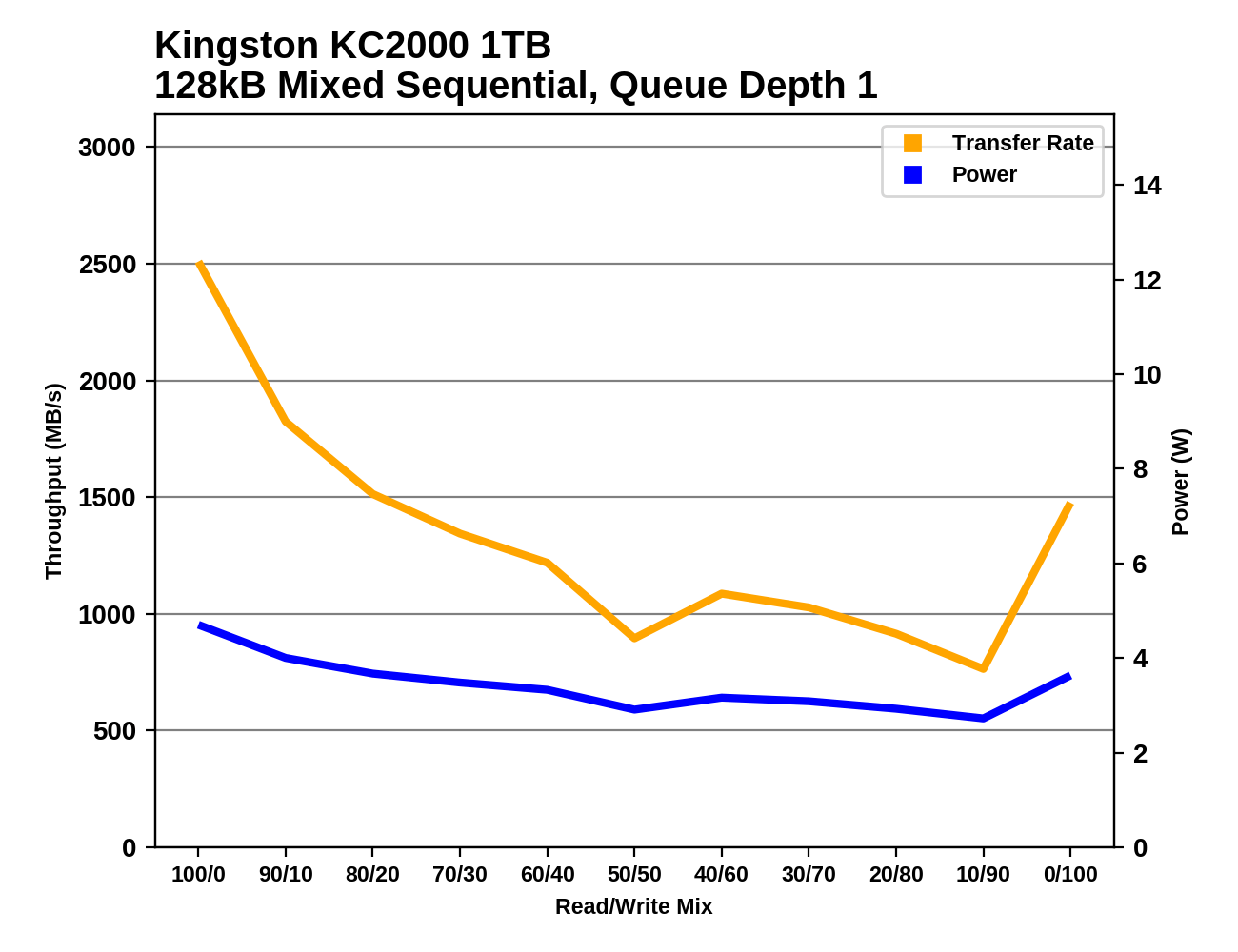The Kingston KC2000 SSD Review: Bringing BiCS4 To Retail
by Billy Tallis on July 22, 2019 8:00 AM ESTMixed Random Performance
Our test of mixed random reads and writes covers mixes varying from pure reads to pure writes at 10% increments. Each mix is tested for up to 1 minute or 32GB of data transferred. The test is conducted with a queue depth of 4, and is limited to a 64GB span of the drive. In between each mix, the drive is given idle time of up to one minute so that the overall duty cycle is 50%.

The Kingston KC2000 performs well on the mixed random IO test. It's a bit slower overall than the ADATA SX8200 Pro that uses the same controller, but still fast enough for this market segment.
 |
|||||||||
| Power Efficiency in MB/s/W | Average Power in W | ||||||||
The power efficiency of the KC2000 during the mixed random IO test is second-tier, falling behind the Toshiba and WD drives that also use BiCS TLC and the ADATA SX8200 Pro that uses Micron NAND with the same SM2262EN controller as the KC2000.
 |
|||||||||
The ADATA SX8200 Pro with Micron NAND earns a higher overall score than the KC2000 largely due to better performance on the more read-heavy half of the test, while the KC2000 mostly catches up during the write-intensive portions. The Samsung 970 EVO Plus by contrast earns its advantage primarily from better performance during the write-heavy half of the test.
Mixed Sequential Performance
Our test of mixed sequential reads and writes differs from the mixed random I/O test by performing 128kB sequential accesses rather than 4kB accesses at random locations, and the sequential test is conducted at queue depth 1. The range of mixes tested is the same, and the timing and limits on data transfers are also the same as above.

On the mixed sequential read/write test, the Kingston KC2000 is slower than most high-end NVMe SSDs, though it does significantly outperform the Toshiba XG6 that relies on the same 96L TLC NAND.
 |
|||||||||
| Power Efficiency in MB/s/W | Average Power in W | ||||||||
The subpar performance of the KC2000 on the mixed sequential test carries over to its efficiency score. The KC2000's power draw is about average, but it doesn't deliver quite as much performance within that power envelope.
 |
|||||||||










29 Comments
View All Comments
LtGoonRush - Monday, July 22, 2019 - link
The Silicon Power P34A80 uses the same controller and NAND as the MP510, but with newer, better-performing firmware.Death666Angel - Monday, July 22, 2019 - link
Do they use custom FW or just stock Phison one? You can install 12.3 (which I think is the latest) stock Phison FW on the MP510.LtGoonRush - Monday, July 22, 2019 - link
It's stock Phison firmware, I thought Corsair didn't offer their own firmware updates for the MP510 (like many vendors) but I could be wrong. I know there's a method to flash the Phison reference firmware onto a reference drive, but I would only recommend that to the adventurous who don't mind wiping their drives.Death666Angel - Tuesday, July 23, 2019 - link
Oh, Corsair doesn't offer the newest FW by themselves, I was refering to the stock Phison one that you can flash. :) Haven't seen anyone report a brick so far and the only people who might get a wiped drive are updating from way early FW as far as I saw. But doing a FW update and not backing up is just asking for trouble, whether it be official or not.sandberg123 - Monday, August 5, 2019 - link
Actually, this will be faster than the 970 EVO in real life.Foeketijn - Monday, July 22, 2019 - link
If I were in the SSD R&D business and not working for SAMSUNG, I would be getting depressed by now.Alistair - Monday, July 22, 2019 - link
You must only be looking at The Destroyer? Too long and too read heavy? If you look at the Heavy test actually I think Adata is killing Samsung in overall performance for way less money. Just don't use the drive full that's all, easy enough to do when you can buy double the amount for the same price.TheUnhandledException - Tuesday, July 23, 2019 - link
If you have to keep the drive half empty to avoid losing performance then the effective price per usable GB is higher than the list price. I agree ADATA is a good value for the buck but I wouldn't say they are killing Samsung (or anyone else) in the heavy benchmark.Strikamos - Tuesday, July 23, 2019 - link
I'm planning on buying the Corsair MP510! Does it have the same problem as the ADATA? Loosing performance when full.. Thank youDeath666Angel - Tuesday, July 23, 2019 - link
Every consumer SSD ever loses some performance when 100% full. Some are better (overprovisioning from the factory, SLC, MLC, TLC, QLC, TRIM, garbage collection, write amplification, wear leveling etc.) than others. TLC with SLC caches (which is the norm and great bang/buck) have a smaller SLC cache the fuller the drive gets. 42GB at empty is a typical figure for 512/1TB drives I think and it gets smaller. Keeping 10% free was an often advised figure in the days of MLC and garbage collection routines. I'd stick to that or 50/100 GB depending on size. My 1 TB system SSD has between 50 and 150GB free and I don't want to go below 50GB free. Things have generally become much better and if you run consumer workloads you will hardly notice a difference going nearly full.